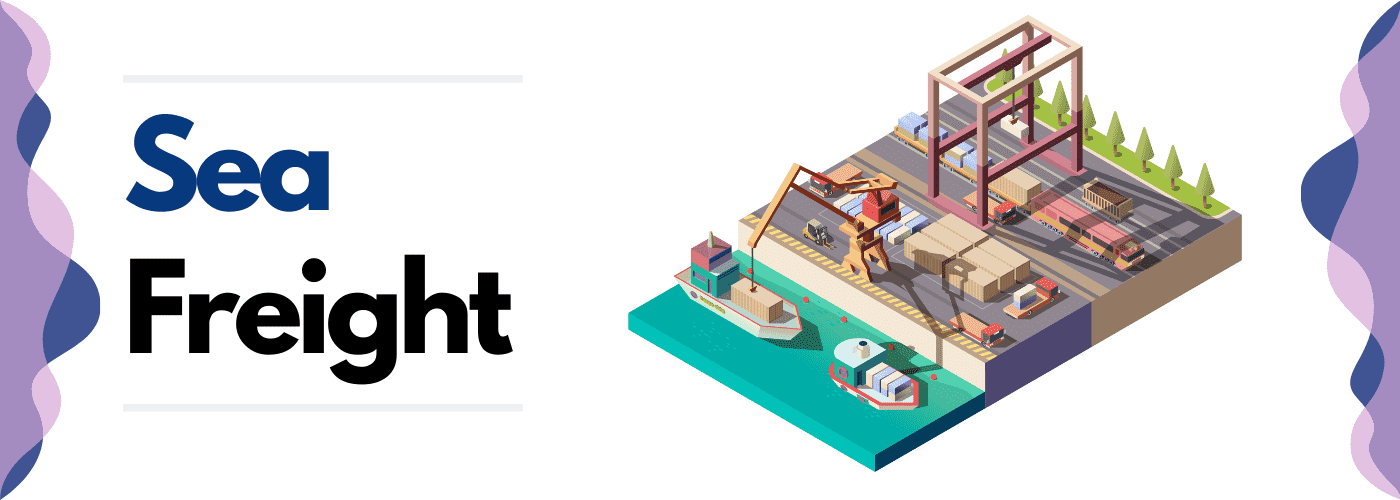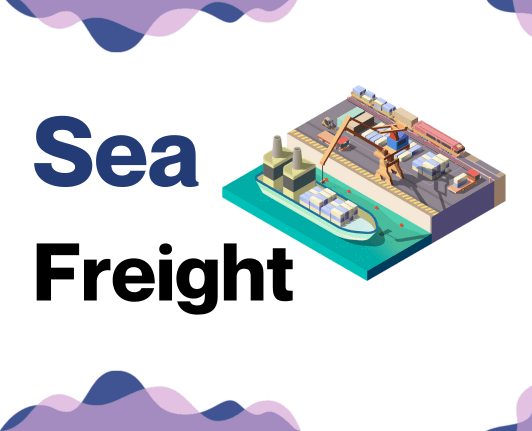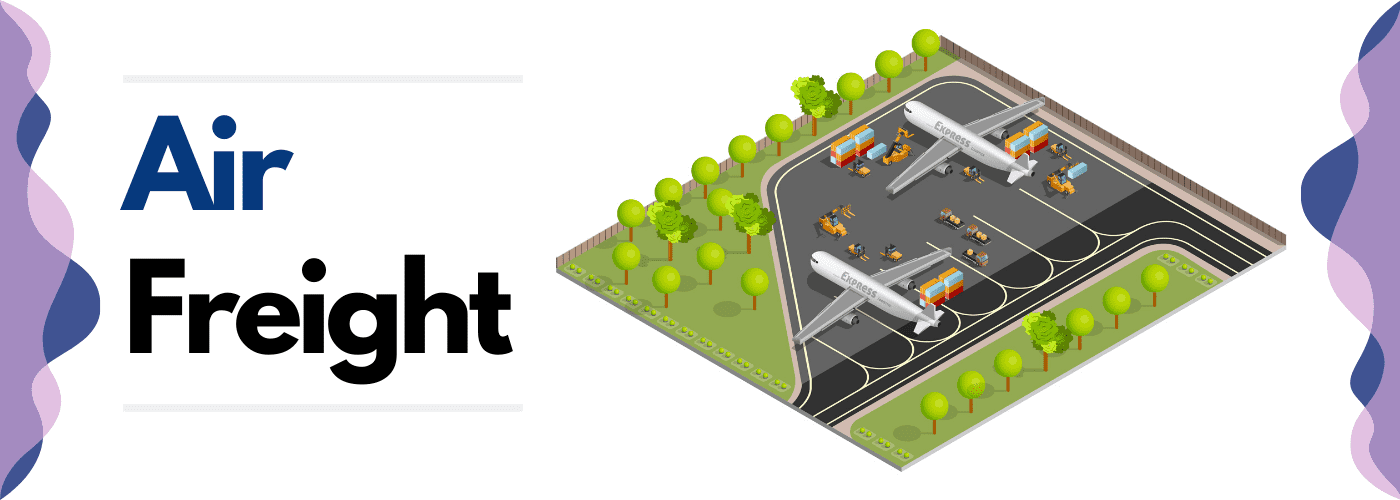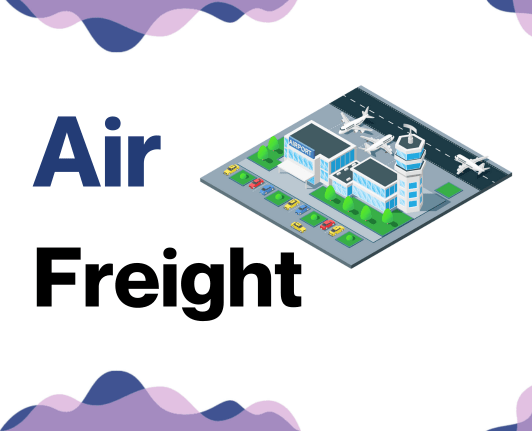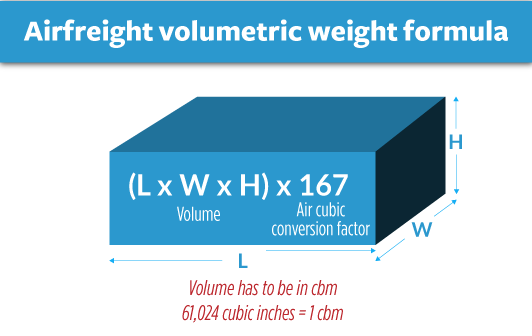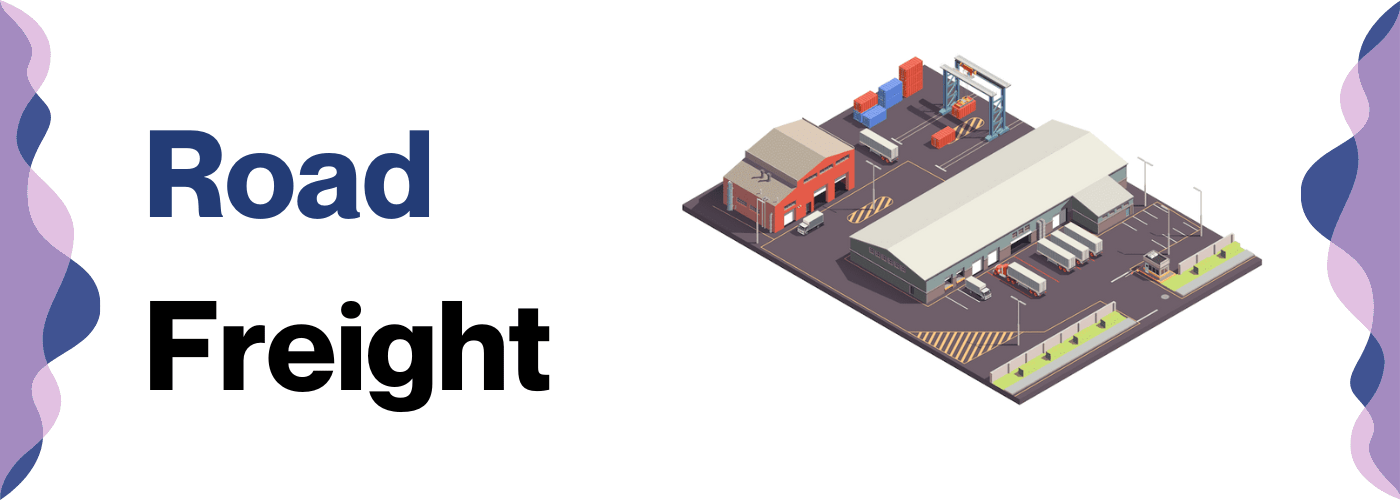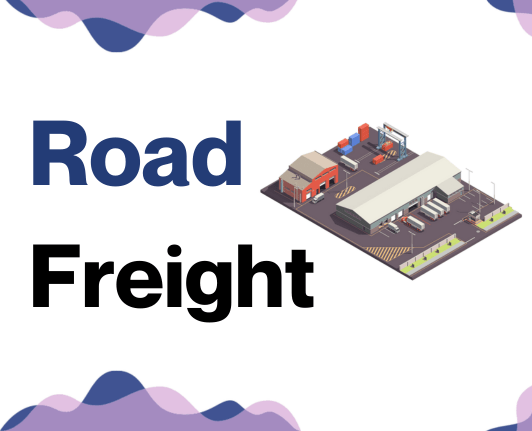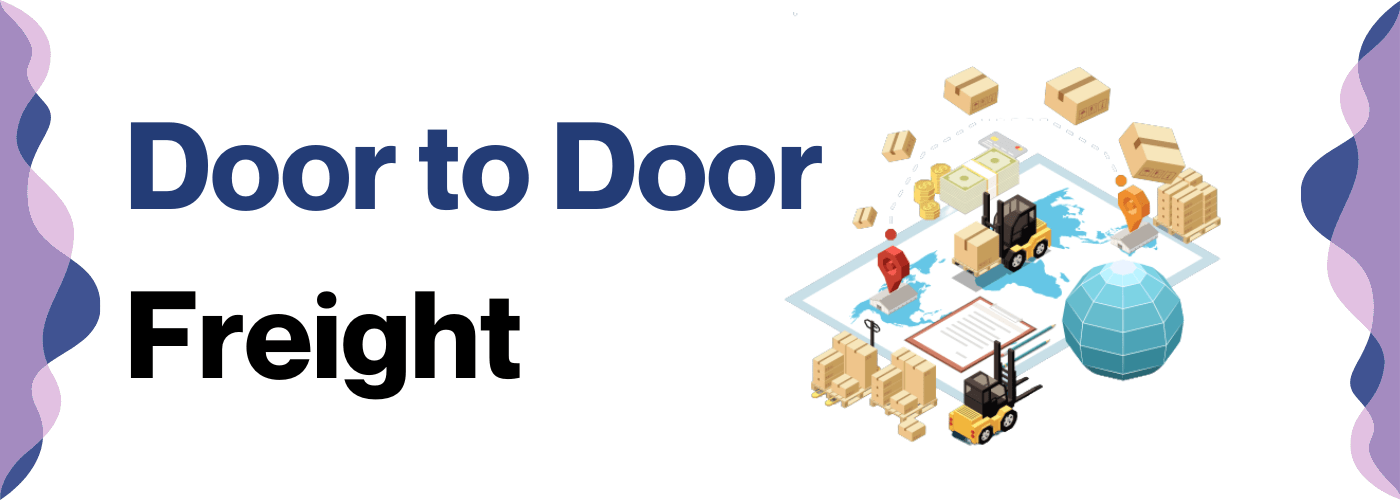Ever tried playing Tetris with a shipment of British tea and Czech crystal? It's an art to master, especially when grappling with the tricky aspects of understanding rates, transit times, and the maze otherwise known as customs regulations.
In this comprehensive destination guide, we will shed light on the ins and outs of transporting goods between the UK and Czechia. We delve into the world of different freight options – be it air, sea, road, or rail, understanding how to clear customs without a hitch, avoiding unexpected duties and avoiding taxes that could rapidly eat into your profits.
Moreover, we offer sound advice tailored for businesses to streamline their logistics and trade smoothly across borders. If the process still feels overwhelming, let DocShipper handle it for you! As an international freight forwarder, we turn logistics challenges into success stories each day, taking care of every step of your shipping journey.
Table of Contents
Which are the different modes of transportation between UK and Czechia?
Choosing the ideal way to transfer goods between UK and Czechia often feels like solving a puzzle. You're dealing with multiple factors - distance, borders, speed demands - and you need to find that perfect transportation method that completes your jigsaw.
It's like deciding between sprinting and cycling a mile - both get you there, but one might suit you better. Whether you're thinking speedy air freight, reliable rail, swift sea, or cost-efficient road transport, consider your shipment's specific needs to ensure you're making the perfect choice for the journey. Time, cost, and volume are pivotal in this decision-making process. Remember, one size doesn't fit all!
How can DocShipper help?
Facing challenges in shipping goods between the UK and Czechia? DocShipper's got you covered! We handle everything from transport organization to clearing customs. Our diligent and friendly consultants are always available. Have questions or need a free estimate? Just give us a call, we're here to help.
DocShipper Tip: Ocean freight might be the best solution for you if:
- You're dealing with large quantities or oversized items. Sea freight offers a budget-friendly way to maximize space, a particularly useful option given the UK's extensive port network.
- Your shipment isn't on a tight schedule. Ocean transport typically takes longer than air or rail, but it offers reliability.
- Your supply chain involves key ports, allowing you to take advantage of a wide-reaching network of sea lanes.
Sea freight between UK and Czechia
UK and Czechia enjoy a thriving trade relationship, with ocean shipping playing a pivotal role in connecting the industrial hubs of these two nations. Picture this: Mammoth vessels transporting high-volume goods from the bustling Port of Felixstowe in the UK to the state-of-the-art Port of Hamburg, and then onto Czechia by rail or road.
It may be a gradual journey, but it's a cost-effective solution, especially for high-volume goods. Imagine an orchestra, where each performer plays in harmony towards the finale—they just take their own time.
However, the symphony of sea freight comes with its dissonant notes. Like a complex dance, many shippers trip over the intricate steps—handling hard-to-decipher paperwork, grappling with customs procedures, or simply picking the wrong container.
In the subsequent sections, we'll guide you through these common missteps, and equip you with tried and tested sea shipping practices. Consider us your shipping melody masters, helping you fine-tune your freight strategy!
Main shipping ports in UK
Port of London
Location and Volume: Situated along the River Thames, the port handles over 50 million tonnes of cargo annually, making it Britain's second largest port.
Key Trading Partners and Strategic Importance: Major trading partners include the EU, North America, and Asia. The port is a vital hub for the UK's supply chain, particularly in sectors such as food, retail, and construction.
Context for Businesses: If you're targeting the UK market or looking at the European continent, the Port of London with its high capacity and rich network of trade routes could serve as an important node in your shipping strategy.
Port of Southampton
Location and Volume: Located on England's south coast, this port sees an estimated annual shipping volume of over 1 million TEU.
Key Trading Partners and Strategic Importance: The Port of Southampton has strong trade links with Asia, America, and Europe. It’s especially known for automobile trade with nearly 900,000 vehicles passing through each year.
Context for Businesses: If you're in the automotive sector or keen on accessing markets in Asia and the Americas, the Port of Southampton could work favorably in your shipping strategy, given its prowess in handling and shipping vehicles.
Port of Felixstowe
Location and Volume: As the busiest container port in the UK, located in Suffolk, Felixstowe handles more than 4 million TEUs each year.
Key Trading Partners and Strategic Importance: It has prime trade links with Asia, North America, and Europe, and boasts the country's largest container terminal.
Context for Businesses: For businesses focusing on the Asian market or ones who have high-volume shipments, the Port of Felixstowe might be the best choice, given its vast capacity and trade links.
Port of Liverpool
Location and Volume: Situated on the West Coast, it is the largest freight terminal in the UK and handles over 700,000 TEUs each year.
Key Trading Partners and Strategic Importance: The port has key trading ties with Asia, the Americas, and Africa as well as being a central logistics hub in Northwest England.
Context for Businesses: If you're exploring new markets in Africa or dealing with large cargo volumes, the Port of Liverpool could be a viable route in your trading strategy owing to its extensive connections and freight capabilities.
Port of Immingham
Location and Volume: Based on the East coast of England, this port deals with over 55 million tonnes of goods per year.
Key Trading Partners and Strategic Importance: Trading partners include continental Europe, and the port is particularly important for coal, petrochemicals, and cars.
Context for Businesses: If you deal in coal, cars, or petrochemicals and aim to penetrate European markets, choosing the Port of Immingham as a logistics pivot makes significant strategic sense.
Port of Dover
Location and Volume: Located in the south-east, it is Europe's busiest ferry port and deals with around 2.5 million trucks per year.
Key Trading Partners and Strategic Importance: Importing mainly from Europe, it serves as a vital link to the continent.
Context for Businesses: The Port of Dover is likely to be a primary component of your logistics if you're seeking to capitalize on the European market given its high volume of ferry traffic and import capabilities.
Main shipping ports in Czechia
Port of Decin
Location and Volume: Located in the city of Decin in Northern Bohemia on the river Elbe, the Port of Decin is the largest inland port in the Czech Republic. It plays a central role in trade with countries along the Elbe river and beyond, handling over 1.5 million tons of freight annually.
Key Trading Partners and Strategic Importance: Decin’s primary trading partner is Germany given its geographical proximity. However, goods also route to the Baltic Sea, gaining access to Northern Europe. The port's strategic location, coupled with it being an important railway node, enhances its trade significance.
Context for Businesses: If you're planning to establish or expand routes to Central or Northern Europe, the Port of Decin might be a key aspect of your logistics strategy, due to its central position in European trade arteries and its proximity to large consumer markets in Germany.
Port of Prague
Location and Volume: Positioned in the capital of Czech Republic, the Port of Prague is another important inland port. Located on the Vltava River, it facilitates access to the Elbe River, and handles around 800,000 tons of goods annually.
Key Trading Partners and Strategic Importance: The port's main trade partners are countries along the Elbe and Vltava rivers, emphasizing import/export relationships with Germany in particular. Its location in the capital city also amplifies its strategic importance.
Context for Businesses: If your business intends to reach markets in key central European locations or capital city consumer clusters, the Port of Prague should feature in your logistics considerations owing to its accessibility, flexibility in handling cargo and close ties to lucrative markets.
While Czechia does not feature coastal ports owing to its landlocked position, these primary inland ports serve as crucial nodes for businesses looking to navigate the European freight landscape. Their central location, well-connected transport networks, and significant trade volume make them indispensable parts of a robust shipping strategy for any business seeking to make inroads into Europe.
Should I choose FCL or LCL when shipping between UK and Czechia?
Deciding between consolidation or full container when shipping from the UK to Czechia? This decision can steer the course of your entire freight experience! There's a balance to be struck, as the right choice can be a game-changer, influencing cost-efficiency, time management, and the success of your shipment.
Now, let's dive in to understand these two main sea freight methods - FCL and LCL, so you can chart the best route for your business needs. Rest assured, we'll help you captain this ship with ease.
LCL: Less than Container Load
Definition: LCL (Less Than Container Load) shipment is employed when you have a smaller amount of cargo that won't fill a standard container. With LCL freight, several shippers share the space in one container, thereby optimizing capacity and keeping costs down.
When to Use: If your cargo volume is less than 13-14-15 CBMs, you should consider LCL shipping. Additionally, LCL provides flexibility as it allows for shipments to be despatched sooner without waiting for a full container load.
Example: Let's take an example of a UK business that needs to ship 10 CBMs of widgets to Czechia every month. Waiting to fill a 20-foot container (33 CBMs) would lead to unnecessary delays. In this case, using LCL shipping would expedite the process and prevent inventory pile-up.
Cost Implications: While the cost per CBM may be higher in LCL compared to Full Container Load (FCL), overall shipping costs end up lower for LCL shipment when cargo volume is less than half the container size. This discrepancy is due to fixed costs in FCL shipping such as container handling and other flat fees, regardless of the container load. It's important to calculate freight charges accurately to assess the most cost-effective and efficient method for your shipping needs.
FCL: Full Container Load
Definition: FCL, or Full-Container-Load, is a type of shipping where a single consignment fills an entire container, either 20'ft or 40'ft.
When to Use: If your cargo is substantial, typically more than 13/14/15 CBM, opting for FCL shipping can be more economical and safer. This method is preferable as you pay for the whole fcl container, irrespective of whether it is entirely filled. In addition, the container remains sealed from the point of origin to your destination in Czechia, safeguarding the contents.
Example: Let's say you are a UK-based furniture business exporting large dining sets to Czechia. Given the bulk and sensitive nature of your cargo, FCL would be the best option. Your 40'ft container would safely house the items, ensuring they arrive intact.
Cost Implications: While an FCL shipping quote might seem higher at first glance due to the price for the entire container, it becomes cheaper when dealing with larger volumes. By dividing the total cost by the volume of goods being transported, the cost per unit can be significantly lower than other methods. However, bear in mind additional fees such as container service charges may apply, influencing the final cost.
Unlock hassle-free shipping
When shipping between the UK and Czechia, choosing between consolidation or a full container can feel like a daunting task. But with DocShipper, shipping becomes hassle-free. Our ocean freight experts carefully consider key factors, such as your shipment volume, budget, and schedule, to recommend the most efficient solution for your business. Don't get lost in the logistics maze—let DocShipper guide your cargo to its destination. Reach out now for a free estimation on your shipping needs.
How long does sea freight take between UK and Czechia?
On average, sea freight shipping between the United Kingdom and Czechia takes about 14 to 20 days. Various factors influence this time frame; specific ports of origin and destination, the weight of your shipment, and the nature of goods being transported. For a more personalized quote and time estimate, it's highly recommended to contact a professional freight forwarder like DocShipper.
How much does it cost to ship a container between UK and Czechia?
Determining the exact shipping cost per CBM between the UK and Czechia can be complex, given the volatile nature of ocean freight rates and multiple influencing factors.
Your final cost is shaped by elements such as Point of Loading, Destination, the carrier, nature of goods, and monthly market fluctuations. Therefore, providing a broad price range is more realistic.
But worry not! Our shipping specialists excel in piecing together competitive quotes, tailored to your specific needs on a case-by-case basis. Getting the best rates for your shipment is within your reach with our personalized services.
Special transportation services
Out of Gauge (OOG) Container
Definition: An Out of Gauge (OOG) container, as its name suggests, refers to any cargo that exceeds standard shipping container dimensions – such as oversized machinery, equipment, or parts.
Suitable for: The OOG containers are ideal for businesses that need to transport out of gauge cargo – i.e., items that can't fit within standard containers due to their weight or dimensions.
Examples: Big machinery such as tractors, industrial equipment, or any oversized objects.
Why it might be the best choice for you: If your business deals with goods that don't fit in standard dimensions, selecting an OOG container would ensure safe and efficient transportation.
Break Bulk
Definition: Break bulk refers to goods that need to be loaded individually rather than in bulk. These are typically bagged or boxed and then loaded on a pallet or crate before being loaded onto the ship.
Suitable for: This method is suitable for businesses that deal with goods that cannot be containerized due to their size, weight or shape.
Examples: Construction equipment, oil and gas materials, or other loose cargo loads.
Why it might be the best choice for you: If the nature of your goods doesn't allow for traditional containerization, break bulk shipping offers an effective solution.
Dry Bulk
Definition: Dry bulk represents goods that are shipped in large quantities in their raw form - like coal, grain or minerals.
Suitable for: Businesses involved in the movement of bulk commodities - such as farmers, miners, and aggregate producers.
Examples: Coal, iron ore, grains or any other similar commodities fit under dry bulk category.
Why it might be the best choice for you: Dry bulk shipping is efficient and cost effective for large quantities of raw, loose goods.
Roll-on/Roll-off (Ro-Ro)
Definition: Roll-on/Roll-off, or ro-ro, shipping involves vehicles or machinery that drive on and off a specialized ro-ro vessel on their own wheels or on a trailer.
Suitable for: Businesses dealing with vehicles, trailers, heavy equipment, or anything else on wheels.
Examples: Cars, trucks, buses, trailers, and even construction equipment.
Why it might be the best choice for you: The ro-ro method is perfect if you need to transport wheeled cargo in a simple and cost-effective manner.
Reefer Containers
Definition: Reefer containers are temperature-controlled shipping containers, designed to keep perishable or temperature-sensitive goods at a constant climate.
Suitable for: Businesses transporting perishable food items, pharmaceuticals, or any goods requiring controlled temperatures.
Examples: Fresh fruits, vegetables, meat, dairy products, or cocktails.
Why it might be the best choice for you: If your cargo needs a specific temperature to maintain its quality, Reefer Containers are the ideal choice to ensure the freshness and quality of your goods.
Understanding these different sea freight options will help you select the right choice for shipping goods between the UK and Czechia. However, choosing the right shipping method can be complicated. At DocShipper, we're experts in logistics. We can advise on the most suitable method for your specific needs. Contact us now and receive a free shipping quote in less than 24 hours!
DocShipper Tip: Air freight might be the best solution for you if:
- You're facing tight deadlines or need rapid delivery. Air freight is your quickest option, which aligns well with the fast-paced business environment.
- Your shipment is relatively small, under 2 CBM. Air freight is ideal for these more compact loads.
- Your cargo's destination isn't easily reached via sea or rail. This makes air freight a viable option, especially given the extensive network of airports available.
Air freight between UK and Czechia
When it comes to speed and reliability, air freight between the UK and Czechia is a game changer. Think of it like a relay racer - quick, agile, and always on time.
Especially if you're shipping small, high-value items (think top-notch electronics or specialty automobile parts), air freight is your best bet. It's the unparalleled choice for efficiency and keeping your precious shipment safe.
But hold on! Picking air freight is just half the battle. Many shippers forget there's more to it than just bundling up the package and waving it off. Cost estimation, for example, is a common pitfall - you might think you're playing a friendly game of catch, only to realize you've actually joined a rugby scrum.
Things like not using the correct weight formula to calculate shipping costs can have you paying more than you bargained for. Similarly, not knowing the rules of the game, the best practices of air freight, can cost you a pretty penny. In the next sections, we'll spotlight these pitfalls and reveal how to avoid them, ensuring your shipping experience is more streamlined, less rugby scrum.
Air Cargo vs Express Air Freight: How should I ship?
Want to send goods from the UK to Czechia rapidly? You've two choices - air cargo, where your consignment hitch a ride with others in a passenger or cargo airline, or express air freight, with a dedicated plane just for you.
But which one fits your trade needs the best? Let's dive in and help you make an informed decision!
Should I choose Air Cargo between UK and Czechia?
If you're shipping goods that surpass 100/150 kg (220/330 lbs) limit, air cargo can be a cost-effective and reliable choice. British Airways and CSA Czech Airlines are notable carriers offering services between the UK and Czechia.
As one of the world's largest airlines, British Airways guarantees regular and express services. On the other hand, CSA Czech Airlines would give you a strong foothold in eastern Europe. Yet, keep in mind that fixed schedules might lead to longer transit times.
However, the proven reliability and cost-effectiveness of air freight may make this the right fit for your business logistics needs.
Should I choose Express Air Freight between UK and Czechia?
Considering urgent shipments or smaller volumes of under 1 CBM or 100/150 kg (220/330 lbs)? Express Air Freight might be your best bet. Using dedicated cargo planes (sans passengers), services like FedEx, UPS, or DHL ensure speedier delivery times, making it highly advantageous for your swift business needs. Check these providers for more detail, as express air freight could be the perfect solution for your UK to Czechia shipping requirements.
Main international airports in UK
Heathrow Airport
Cargo Volume: Heathrow is the UK's busiest cargo airport, handling over 1.4 million tonnes of cargo in 2023.
Key Trading Partners: The majority of Heathrow's cargo trade is with the USA, followed by China, and the Middle East.
Strategic Importance: Its strategic location in London, coupled with its extensive global network of over 200 destinations, makes Heathrow an indispensable hub for international freight.
Notable Features: The airport boasts two parallel runways and five terminals, and a specific cargo area providing a streamlined process for cargo transport.
For Your Business: If your business requires frequent and efficient transport to a wide range of international locations, especially North America and Asia, then Heathrow's impressive connectivity could aid in logistics planning and implementation.
East Midlands Airport
Cargo Volume: The airport handles around 370,000 tonnes of cargo annually, making it the second busiest cargo airport in the UK.
Key Trading Partners: Main trading partners include the EU, specifically Germany, and North America.
Strategic Importance: It serves as a significant hub for several major courier companies, including Royal Mail, DHL, and UPS.
Notable Features: East Midlands is known for its efficient 'Express Freight' service, which expedites the send/receive process for time-critical shipments.
For Your Business: If your product relies on quick, time-sensitive delivery or if you frequently ship to/from the EU or North America, East Midlands could be a strategic choice for your cargo needs.
Manchester Airport
Cargo Volume: Manchester Airport processes approximately 120,000 tonnes of import and export freight and mail annually.
Key Trading Partners: Its key freight destinations include the USA, UAE and other parts of the Middle East.
Strategic Importance: As the third largest airport in the UK, it connects the north of England to the global trade network.
Notable Features: The airport hosts three terminals and a World Freight Terminal, designed specifically to handle cargo operations.
For Your Business: If your company is situated in the northern UK and trades primarily with the US and Middle East, then Manchester airport may act as a local, strategic hub for your shipping strategy.
Stansted Airport
Cargo Volume: Stansted handles over 250,000 tonnes of cargo each year.
Key Trading Partners: The airport's major trading partners include Hong Kong, the USA, and EU countries.
Strategic Importance: Stansted is home to one of the largest freight hubs in the country, and includes FedEx and UPS among its resident carriers.
Notable Features: Stansted's specific cargo terminal, set away from the main passenger terminals, provides a dedicated hub for efficient cargo handling.
For Your Business: If your business is based in the South East and requires transportation facilities with prominent courier companies, or if you trade primarily with Asia or USA, Stansted is an ideal choice.
Gatwick Airport
Cargo Volume: Gatwick handles over 90,000 tonnes of cargo annually.
Key Trading Partners: Main trading partners include EU countries, North America, and parts of Asia.
Strategic Importance: As the UK's second largest airport, it's an important supporting node for businesses that need supplemental cargo routes to Heathrow.
Notable Features: Gatwick boasts a highly streamlined cargo transportation process, facilitated by a dedicated cargo terminal and key cargo airlines.
For Your Business: If you need additional shipping routes alongside Heathrow, particularly to Europe and North America, Gatwick could be a potentially advantageous and strategic alternative.
Main international airports in Czechia
Vaclav Havel Airport Prague
Cargo Volume: Vaclav Havel Airport manages an impressive cargo volume of over 2,500 tons monthly, facilitating a robust flow of goods from Prague to the world.
Key Trading Partners: The airport has active trading collaborations with numerous countries, but especially with Germany, China, and Russia.
Strategic Importance: Being the main international airport in Czechia, it connects the heart of Europe with the world, offering numerous flights and logistic options for international trade.
Notable Features: It features a dedicated cargo terminal that's open 24/7 and equipped with cutting-edge technology for efficient cargo handling, ensuring your goods are in safe hands.
For Your Business: If you're looking to connect your business with European and Asian markets, Vaclav Havel Airport stands as an essential hub with a reliable cargo network offering frequent connections and efficient transit times. This airport might be your best bet for reaching these key markets with maximum efficacy.
Brno-Turany Airport
Cargo Volume: Its monthly cargo capacity is impressive with upwards of 1,000 tons, making it a significant international cargo relay point.
Key Trading Partners: Its strategic location near the industrial heart of Czech Republic puts it in close range with partners such as Germany, Austria, and Slovakia.
Strategic Importance: Brno-Turany provides an important bridge between Eastern and Western Europe, thus making it a key player in the international logistics chain.
Notable Features: The airport boasts special facilities for handling dangerous and perishable goods, demonstrating extreme care and precision for your precious consignments.
For Your Business: If your business involves shipping sensitive items, Brno-Turany Airport offers the specialist care these items require. Moreover, its strategic location provides your business with a swift gateway to both Eastern and Western Europe.
Pardubice Airport
Cargo Volume: The airport handles over 200 tons of cargo monthly, providing an alternative shipping point to the more congested airports.
Key Trading Partners: It has strong trading partnerships with countries in East Asia, specifically China, as well as Russia and Germany.
Strategic Importance: It serves as a secondary nucleus for cargo and passenger movement, thereby lightening the load on the main Prague airport.
Notable Features: Pardubice stands out with its 24x7 operational hours and the capacity to handle large-sized aircraft, making it an attractive option for firms seeking heavy cargo volume shipping opportunities.
For Your Business: If your business is shipping bulk goods or requires hassle-free operations, the lesser-trafficked Pardubice Airport could be your convenient logistics solution. Its capacity to handle larger planes aids in large scale transport while keeping operations streamlined.
How long does air freight take between UK and Czechia?
Estimated average shipping time from the UK to Czechia via air freight is typically 1 to 2 days. However, bear in mind these timelines can fluctuate based on specific variables. The transit time depends critically on the chosen airports, the weight of freight, and the nature of goods being transported.
To ascertain the most accurate shipping times for your specific consignments, it's recommended to seek advice from an experienced freight forwarder like DocShipper.
How much does it cost to ship a parcel between UK and Czechia with air freight?
Estimating an average, air freight cost could range from £2.00 to £3.50 per kilogram between the UK and Czechia. However, a myriad of factors such as the proximity of the departure and arrival airports, parcel dimensions, weight, and nature of goods significantly impact the final cost.
Thus, guaranteeing a precise cost isn't practical. Our experienced team tailors each quote to the client's specific requirements, ensuring the most competitive rates. For a custom, no-obligation quote within 24 hours, please don't hesitate to contact us.
What is the difference between volumetric and gross weight?
Gross weight refers to the actual weight of a shipment, including all packaging and pallets. In air freight shipping, it's simply what you'd see if you put your cargo on a scale. On the other hand, volumetric weight considers how much space your shipment takes up in the aircraft. It's not about the physical weight, but the weight in terms of space.
Calculating gross weight in Air cargo and Express Air Freight is straightforward - you just weigh your packaged shipment. For example, if your packed goods weigh 100 kg (or approximately 220 lbs), that's your gross weight.
Volumetric weight calculation is a bit different. In Air cargo, it's calculated by multiplying the length, width, and height (in cm) of your packaged shipment, divided by 6,000. In Express Air Freight, the same calculation applies, but you divide by 5,000 instead.
For instance, if you have a box with dimensions 120 cm (Length) x 100 cm (Width) x 150 cm (Height), the volumetric weight in Air cargo would be 300 kg (or around 661 lbs), and in Express Air Freight, it would be 360 kg (or nearly 794 lbs).
The relevance? Freight charges. In air freight, you'll be charged based on whichever is higher: the gross weight or the volumetric weight. It's a system designed to ensure fair compensation for the carriers, considering both space and weight factors. So, understanding and calculating both weights is key to anticipate your shipping costs.
DocShipper tip: Road freight might be the best solution for you if:
- You're seeking a budget-friendly solution for shorter hauls. Road freight often comes out on top in terms of cost-effectiveness and speed for these kinds of distances.
- Your end destination is either within your own continent or just across the border. For such regional or intra-continental shipments, road freight is typically the most direct and rapid method.
- Your cargo has unique dimensions or shapes. The adaptability of trucking allows for a wide range of goods that may not conform to the size limitations of sea or air transport.
Trucking between UK and Czechia
Trucking services from the UK to Czechia offer an appealing balance between cost, speed, and simplicity. Typically, transit times range from 3-5 days. The main route traverses Europe's top-notch road network, including Germany's Autobahns, making for smooth and timely transport.
Compared to sea or air, trucking can strike a fantastic cost-to-time ratio for specific goods. However, businesses must be mindful of the goods' nature, potential road transport restrictions, and the environmental impact. Weigh your needs against these pros and cons, as trucking might be your most pragmatic and economical freight option.
What if I can’t fill a truck between UK and Czechia?
Unraveling the freight options between the UK and Czechia? Every penny matters, so here's your ultimate comparison: Less than Truckload (LTL) versus Full Truckload (FTL).
Perfect for savvy businesses, this breakdown will shed light on flexible, cost-efficient solutions tailored for your unique shipping needs. Stay tuned and make your logistics work smarter, not harder!
LTL: Less than Truck Load
Stepping into the world of international shipping, Less Than Truckload (LTL) freight is where multiple shipments from different shippers are consolidated into one truck. It's a fabulous option when the cargo volume is less than 13/14/15 CBM. Why, you ask? Because you only pay for the space you use, making it a convenient and cost-effective choice.
Imagine you're a furniture designer based in the UK, eager to send a batch of artisanal chairs to a boutique in Czechia. Each chair takes up about 2 CBM, and you have six of them. So, you need around 12 CBM, which aligns perfectly with LTL shipment.
Now, identifying the right shipping scenario for LTL isn't always straightforward. Here are a few use cases to guide your decision:
- Your cargo volume is between 1 and 15 CBM.
- You're willing to share container space with other shippers.
- The goods are flexible on delivery time – LTL might require a couple of extra days due to multiple stops.
- The freight isn't time-sensitive.
- The goods are less vulnerable to damage or theft during transit.
In essence, LTL freight is a perfect blend of practicality and affordability when your shipment volume doesn't fill a whole truck.
FTL: Full Truck Load
Full Truck Load (FTL) shipping is a popular way to transport large amounts of cargo. As the name implies, FTL freight utilizes the entire truck space for one shipment. Let's say you're running a business in the UK but have a hefty order amounting to 14 CBM that needs to be sent to Czechia. A FTL shipment would be ideal in this case because your load fills the entire truck, making it cost-effective and efficient.
When should you pick FTL for your business? Here are a few prompts to consider:
- You're shipping a large amount of goods that can fill an entire truck (more than 13 CBM)
- Ensuring a lower risk of damage is critical for your business, as FTL confines all items to one truck, reducing the risk of mishandling during transit.
- You require faster transit times. With no multiple stops for deliveries, FTL can provide a quicker delivery of your goods.
- The load is high value. Delivering all at once with a dedicated truck adds an additional layer of protection.
Remember, choosing between LTL and FTL all boils down to the nature and volume of the goods you are shipping. Consider these factors and pick the option that serves your needs best.
What are the main routes between UK and Czechia?
When transporting goods by road between the UK and Czechia, your journey often begins on the M20 in London and then crosses over the English Channel via ferry or the Eurotunnel. Once you reach mainland Europe, you would continue via the E40 in Belgium and E50 in Germany. Notable cities en route include Brussels, Frankfurt, and Nuremberg.
Now, imagine crossing the border into Czechia, all amidst the backdrop of Central Europe's captivating landscapes. The route may sometimes be affected by seasonal weather, traffic congestion, and routine road maintenance works, so it's essential to plan accordingly. Make your journey successful with good preparation and the right information. Safe trips!
What are the road transit times between UK and Czechia?
Typically, the average road transport time between the UK and Czechia is around 15 to 20 hours.
However, this can vary considerably; unpredictability in traffic, variable circulation patterns, and in some cases, poor road conditions (as seen in regions of Eastern Europe) can significantly affect travel times.
Remember, these are just estimates; for a specific cross-border freight quote, we are here to assist you within 24 hours.
How much does trucking cost between UK and Czechia?
Calculating the exact price to truck your goods from the UK to Czechia isn't black and white, it's more like a vibrant mosaic of factors. Toss in things like the type of goods, their weight, the route, and voila! - it gets complex.
But hey, worry not. Our logistics wizards will guide you through the whole process, crunching numbers and conjuring the most favorable rates. That's the benefit of our case-by-case approach – we tailor-fit the shipping costs to your needs. Comfy, isn't it?
DocShipper tip: Door to Door might be the best solution for you if:
- You prioritize ease and a hassle-free shipping experience. Door-to-door services manage the entire process, from collection to final delivery.
- You appreciate the efficiency of having one dedicated contact. With door-to-door, a single agent is responsible for overseeing all elements of your shipment.
- You want to limit the number of times your cargo is transferred. Door-to-door services minimize the switches between various transport methods, lowering the chances of damage or loss.
Door to door between UK and Czechia
Unpacking the world of international Door-to-Door shipping, it's the logistic dream that picks up your precious goods from the UK and escorts them right to your doorstep in Czechia.
Offering unparalleled convenience, this shipping method can be a time and effort saver. So, buckle up as we steer you through the ins and outs of Door-to-Door shipping. Let's dive in!
Overview – Door to Door
Shipping your goods from the UK to Czechia? Door to door shipping is your hassle-free option, handling everything from pickup to delivery. Amid complexities of cross-border trade – be it VAT, customs or tracking – this service eases your troubles.
Let us deal with the little details while you focus on your business. Despite being a bit costly, it's DocShipper's most sought-after service because of its convenience and reliability.
Let's take a plunge to understand why it's a game-changer. It’s not about mere shipping; it’s about simplifying logistics. Ready for an easy, reliable shipping journey? Then, keep reading.
Why should I use a Door to Door service between UK and Czechia?
Anyone dealing with shipping knows it's no cakewalk, more like navigating a labyrinth blindfolded. Door-to-door service, especially between the UK and Czechia, is your seasoned guide through the maze. Here's why!
1. Hands-Off Hassle-Free: With an intricate task like shipping, who wouldn't want the breather? Door-to-door service grabs the steering wheel right from picking up your goods, ensuring a seamless and stress-free experience.
2. Punctuality Promised: Urgent shipment? No sweat! The beauty of this service is its dedicated commitment to timeliness. It's designed to navigate through customs clearance swiftly, reaching your destination when you need it.
3. Tender Loving Care: Complex cargo can be like a fussy toddler, it needs special attention. Door-to-door service comes trained in handling such elements, ensuring safe and secure transport.
4. Convenience is King: This service relieves you from the mundane, offering a comprehensive package that handles everything, including trucking, to your desired spot. Pack, relax, and watch your cargo roll all the way to Czechia.
5. Trustworthy Track: Transparency is a game-changer. Door to Door gives you the power to track your shipment's journey, leaving no room for surprises.
Simply put, Door to Door service is your personal logistics concierge, handling every step of the shipment process with care and precision. Who said shipping had to be a headache?
DocShipper – Door to Door specialist between UK and Czechia
Experience seamless door-to-door shipping from the UK to Czechia with DocShipper! Lay back as our skilled team handles all aspects from packing to transportation, utilizing all shipping methods for optimum efficiency.
Gain peace of mind with our dedicated Account Executive serving as your single point of contact. Ready for stress-free shipping from A-Z? Reach out for a free quote within 24 hours or speak directly with our expert consultants. Success, delivered.
Customs clearance in Czechia for goods imported from UK
Customs clearance is the vital part of importing goods, and it's far from simple when moving from the UK to Czechia. It's a maze of unexpected fees, intricate quotas, and specific licenses.
One misstep could mean your goods get stuck in the shipping process, adding costs and time delays - a risk no business wants to face. Understanding the complexities around customs duties and taxes is essential to seamless transport. We've designed the following sections to guide you through this intricate part of international shipping.
And remember, DocShipper can handle it all for any good, anywhere. Need an estimate to budget your project? Our team is ready for your details - origin, goods value, and HS Code. Let us simplify shipping for you.
How to calculate duties & taxes when importing from UK to Czechia?
Deciphering the customs duties maze can be a tad overwhelming, considering every detail matters. Essentially, the calculation process involves elements such as the product's country of origin, its HS Code, the customs value, the applied tariff rate, and potential additional taxes and fees. Without a doubt, identifying the country where the goods were manufactured or produced is your starting line toward determining the exact cost of importation from the UK to Czechia.
Step 1 - Identify the Country of Origin
Identifying the Country of Origin, in this case, the United Kingdom, is your first crucial step in estimating duties and taxes. Here are five reasons that highlight its importance:
1. It can influence the Harmonized System (HS) code, a core part of the goods classification.
2. Different countries have differing duties, taxes, and charges, even for similar goods.
3. Specific trade agreements can impact the customs duties, for instance, the UK-Czechia Trade Cooperation Agreement.
4. Import restrictions vary from country to country, and being clear about the country of origin helps you avoid legal complications.
5. Your shipment's security compliance and paperwork requirements often hinge on its country of origin.
The trade agreement between the UK and Czechia positively affects businesses by mitigating tariffs for products of originating status. However, verify your goods meet the originating requirements outlined in the agreement.
Remember, Czechia, as a member of the EU, can impose some restrictions. Check for the particular limitations on goods brought from the UK. Wisdom lies in being proactive to avoid delays or unexpected costs. Stay well-equipped with the knowledge of your goods' country of origin - it will shield you from numerous headaches down the line.
Step 2 - Find the HS Code of your product
The Harmonized System (HS) code is an internationally recognized system of names and numbers to classify traded products. It is used by customs authorities to identify products for the application of import duties and taxes. Knowing your product's HS code is crucial when trying to navigate the world of international shipping, as it facilitates hassle-free customs clearance.
Usually, your supplier is the best source to provide the HS code for the products you're dealing with. They typically have extensive knowledge about the products they manufacture and the corresponding regulatory nuances, including HS codes.
However, should you need to find an HS code by yourself, we've got you covered. You should follow these easy steps:
1. Head to the Harmonized Tariff Schedule.
2. Place the name of your product into the search bar provided.
3. Review the 'Heading/Subheading' column in the resulting table - this is where you'll find your HS code.
Note: Accuracy is key when dealing with HS codes. An incorrect code may lead to unexpected delays and potential fines. Therefore, it's essential that you double-check this information.
Here's an infographic showing how to read an HS code.
Step 3 - Calculate the Customs Value
Shifting your gaze from the price tag of your product to its customs value is vital when shipping goods from the UK to Czechia. These values differ widely, and it's crucial to understand how.
Think of the customs value as the aggregate escalation of the goods' cost. It's determined by the CIF value, a culmination of the cost of your goods, the expenses of your international shipping, and the insurance cost. For example, if your product costs $100, shipping costs $50, and insurance is $20, your customs value stands at $170. This value is pivotal as it's what Czech customs will use for duty and tax assessments, influencing your bottom line significantly. So, understanding how to calculate it accurately won't just be a boon - it could be a game-changer for your business.
Step 4 - Figure out the applicable Import Tariff
An import tariff is a tax imposed on imported goods, and its purpose is to protect domestic industries and maintain the balance of trade. A specific type of tariff, called an ad valorem tariff, is commonly used—it is set as a percentage of the value of the imported goods.
To identify the applicable tariff for goods imported from the UK to Czechia, you can use the UK's new tool, UK Trade Tariff: look up commodity codes, duty and VAT rates. Here's a quick guide:
1. Enter the Harmonised System (HS) code that you previously identified for your product and the country of origin, which in this case is the UK.
2. The tool will display the duties and value-added tax (VAT) applicable to your product.
To illustrate, let's take an example of a bicycle which has an HS code of 871200. Assuming your bicycle's Cost, Insurance, and Freight (CIF) value is $500:
1. Enter 871200 as the HS code and select UK as the country of origin.
2. The tool might show a tariff rate of 10%.
To calculate the import duties, you apply the tariff rate to the CIF value: 10% of $500 equals $50. So, for a bicycle costing $500 to import, you'll pay an import tariff of $50. This practical, specific information should guide your shipping decisions and financial planning.
Step 5 - Consider other Import Duties and Taxes
In addition to the standard tariff, import duties in Czechia can vary, largely depending upon the origin country and product nature. Let's take a few additional charges into account:
1. Excise Duty: Assessed on specified goods such as alcohol, tobacco, and energy products. If you're importing wine, for example, this might kick in.
2. Anti-Dumping Taxes: Measures taken to protect local industries from unfairly low-priced imports. Suppose you’re shipping aluminium alloys, anti-dumping duties may apply.
3. VAT: This is critical! For imports into Czechia from non-EU countries like the UK, VAT is important. It's charged on the cost of goods + transport costs + import duty. Let's say goods are $1000, freight is $200, and import duty is $150, the VAT would be calculated on $1350.
Remember, these are just examples and actual rates can vary, but the hope is that this helps you understand the varied layers that come into play during customs clearance for Czechia.
Step 6 - Calculate the Customs Duties
When it comes to the customs clearance process in Czechia for goods from the UK, you need to effectively calculate your customs duties.
The customs value forms the basis of your calculation. This includes the cost of your goods, associated transport charges, and any insurance costs. Custom duties are placed on this value, with rates varying depending on the type of product.
Consider three scenarios for better understanding. First, an example of a $500 shipment of kitchenware (2% customs duty), your total customs duty would be $10 (2% of $500) and no VAT.
Next, imagine you're importing pieces of furniture worth $1000 with a customs duty of 3% and a VAT of 15%. Your initial customs duty is $30 (3% of $1000). Add the VAT charged on the cumulative amount ($1030), resulting in a $154.5 VAT. So the total amount payable would be $184.5.
Finally, let’s say you're importing a $4000 shipment of shoes. In addition to a 10% customs duty and a 15% VAT, you're also hit with a 10% anti-dumping tax and a $100 Excise duty. Here, your total customs duty would come up to $4100 including all taxes.
Remember, customs clearance can be complicated, but our team at DocShipper can simplify the process for you. With our robust network and expertise, we ensure you're not overcharged and abide by all regulations. Reach out to us for a free quote in less than 24 hours and experience seamless customs clearance anywhere around the globe.
Does DocShipper charge customs fees?
At DocShipper, we prioritize clarity when it comes to financial aspects of shipping. Although we handle customs clearance in both the UK and Czechia, we don't levy any customs duties. These duties and taxes go straight to the government.
Our fees are for the customs clearance service itself. To ensure this transparency, we provide you with the official documents from the customs office, verifying you've only paid what was demanded by them.
It's like hiring an accountant: they'll charge for their services, but your regular taxes are separate! This way, you can focus on your business without worrying about unexpected costs.
Contact Details for Customs Authorities
UK Customs
Official name: Her Majesty's Revenue and Customs (HMRC)
Official website: https://www.gov.uk/
Czechia Customs
Official name: General Directorate of Customs, Czech Republic
Official website: http://www.celnisprava.cz/
Required documents for customs clearance
Managing smooth international trade can feel like decoding a cryptic puzzle. The key? Understanding critical documents like the Bill of Lading, Packing List, Certificate of Origin, or Documents of Conformity (CE Standard). This guide unveils their significance, helping you conquer customs clearance.
Bill of Lading
When sending goods across the channels, your Bill of Lading (BOL) is akin to a golden ticket. This key document marks the transfer of ownership, from the sender in the UK to the recipient in Czechia. Imagine BOL as your proof of purchase, but in the complex world of international shipping. A telex (or electronic) release can simplify the process, allowing for an immediate transfer once the goods hit Czech shores, skipping physical paperwork. If you're choosing wings over waters, consider an Air Waybill (AWB) – it performs the same function for air cargo. Remember, handle these docs with care; mistakes can mean delays or, worse, your goods being held ransom by customs. Be sure to ask your freight forwarder about the most effective way to handle your BOL. It’ll save you both time and potential headaches.
Packing List
Shipping between UK and Czechia? Get your Packing List right! This unassuming document plays a big part in clearing your goods through customs, regardless of whether you're using sea or air freight. Shippers, you have the key responsibility of providing a detailed, accurate account of all items in your shipment, their weight, and packaging type. For instance, if you're a furniture company shipping flat-pack desks, each screw, bracket, and panel counts! Miss a bolt in your list, and you risk delays and extra costs at customs. So, always triple-check your Packing List and save your business a potential logistical hiccup. The more accurate it is, the smoother your goods will sail (or fly) from UK to Czechia. It's about more than just ticking boxes—it's your ticket to efficient, hassle-free freight forwarding!
Commercial Invoice
The Commercial Invoice, critical in shipping goods between UK and Czechia, details your shipment's value, origin, description, and Harmonized System (HS) codes. Here's a tip: thoroughness matters! Fill out each section accurately to avoid delays or rejections at customs. A perfect example is the HS codes; should they mismatch the product descriptions, it could result in puzzles for customs officers - that's a delay you don't need. Also, ensure consistency between the Commercial Invoice and other shipping documents like the Bill of Lading. With a well-crafted Commercial Invoice, your goods will pass through customs like a breeze, making your business shipments smoother and stress-free.
Certificate of Origin
Navigating customs between the UK and Czechia? One document you won't want to overlook is the Certificate of Origin. This piece of paper is your golden ticket to potential customs duty savings if your goods were manufactured in certain countries. It proves where your goods were made - whether it's porcelain products from Stoke-on-Trent or glassworks from Jablonec. Let's say your shipment of British-made classic cars qualifies for a preferential rate under EU trade agreements. Presenting a Certificate of Origin can slash the customs duties your Czech customer would otherwise have to pay. But remember, it's essential to state the country of manufacture truthfully, as false declarations could result in penalties. A small piece of paper, yes, but a vital one that brings cost savings and smoother clearance. Happy shipping!
Certificate of Conformity (CE standard)
Shipping goods from UK to Czechia, your product needs the Certificate of Conformity to demonstrate compliance with the CE standards, primarily to assure Czechia that your product meets certain safety standards acceptable within the European market. Note, this isn't quality assurance. CE marking focuses on safety standards, while quality assurance is about achieving consistent performance. For a picture with a US connection: think of the CE mark like Underwriters Laboratories or UL standard, a similar safety compliance mark used in America. One way to help you prepare is to consistently engage with accredited testing bodies to handle CE testing and documentation, ensuring smoother customs clearance. Checking out https://www.gov.uk/guidance/using-the-ukca-marking is useful to understand UK's specific requirements since leaving the EU.
Your EORI number (Economic Operator Registration Identification)
Shipping goods from the UK to Czechia? You'll need an EORI Number - it's crucial! This unique ID, issued by Customs, tracks your imports and exports within the Czech Republic and the rest of the EU. Even though the UK isn’t part of the EU anymore, both regions require it for customs clearances. If you're a UK business regularly shipping to Czechia, your life becomes a tad bit smoother with an EORI number – no more hold-ups at customs! Applying for it? Simplified! Just hit the HM Revenue and Customs (HMRC) website for the UK, or the General Financial Directorate for Czechia, and follow the instructions. Remember, no EORI, no clearance!
Get Started with DocShipper
Overwhelmed with customs clearance when shipping from UK to Czechia? You're not alone! Let our experienced team at DocShipper handle all the intricate steps seamlessly. We're only a message away - reach out to us for a free quote! Expect a detailed response within 24 hours to help fast-track your shipments.
Prohibited and Restricted items when importing into Czechia
Understanding what items Czech customs will forbid or limit can be challenging, often leading to shipment delays. This guide will unravel the complexities of importing into Czechia, pointing out what's banned and restricted. Let's keep your cargo moving smoothly by avoiding any unwanted hold-ups.
Restricted Products
1. Pharmaceuticals and Medicinal Products: To import these into Czechia, you'll need permission from the State Institute for Drug Control.
2. Firearms and Ammunition: For these products, you'll have to apply for a special import license from the Czech Police.
3. Plants and Plant Products: These need a Phytosanitary Certificate. You can get it from the Central Institute for Supervising and Testing in Agriculture.
4. Radioactive Materials: You'll be required to obtain a licence issued by the State Office for Nuclear Safety.
5. Food and Agricultural Products: These require import licenses issued by the Czech Ministry of Agriculture.
6. Live Animals and Animal Products: Importing these items requires a Veterinary Certificate of Origin from the State Veterinary Administration of the Czech Republic.
7. Alcoholic Beverages and Tobacco Products: You’ll have to first get a permit for these from the Czech Customs Administration.
Remember, the specific rules can change, so always verify the information directly from the relevant Czech governmental organization mentioned. It's crucial to ensure you're complying with all the latest regulations of Czechia.
Prohibited products
- Narcotic drugs and psychotropic substances.
- All types of ammunition and firearms, including parts thereof.
- Explosive materials and items containing explosives.
- Precursors used in illicit drug production.
- Counterfeit currency and counterfeit stamps.
- Print materials, audio and video recordings aimed to promote violence, racism, or drugs.
- Obscene or immoral materials, child pornography.
- All types of wireless communication jammers.
- Goods infringing upon intellectual property, patent, trademark, design, geographical indication, or copyright (counterfeit goods).
- Certain protected species of plants and animals, products or parts thereof, under the CITES (Convention on International Trade in Endangered Species of Wild Fauna and Flora) agreement.
- Fruit and vegetables unless treated in specific ways to eliminate pests.
- Soil and organic materials that may affect the national biodiversity.
- Counterfeit and pirated goods.
- Cultural artifacts and works of art that are part of Czech's cultural heritage.
- Items bearing false indications of origin.
- Goods that could lead to the misuse of free movement of goods due to public health risks.
- Goods dangerous to human health, life, and the environment.
- Electrical equipment that doesn’t meet European safety standards.
Are there any trade agreements between UK and Czechia
Yes, there are trade agreements between the UK and Czechia that significantly impact your shipping operations. Vital to note is the Trade and Cooperation Agreement (TCA), which governs the trade relationship following the UK's exit from the EU.
While it avoids tariffs and quotas on goods, certain customs procedures and declarations are now necessary. Ongoing talks on further reducing trade restrictions and enhancing transit infrastructure, such as railway lines, might present future opportunities. Understanding these elements is crucial to optimize your shipping process.
UK - Czechia trade and economic relationship
The relations between the UK and Czechia have flourished over the years, both as trading partners and significant investors in each other's economies. The growth traces back to the fall of communism in Czechia in 1989 when Britain began expanding its economic horizons in eastern Europe. Key sectors like Automotive, Engineering, Energy, and IT have since formed the backbone of bilateral trade, with Passenger cars and Industrial machinery being major commodities.
In 2022, Czechia was the UK's 24th largest trading partner globally, with a bilateral trade volume of £9.3 billion. This mutually beneficial exchange sees the UK investing heavily in Czechia. This synergy reflects a partnership that has braved changes in regional and global politics, proving itself to be both valuable and resilient.
Your Next Step with DocShipper
Experienced roadblocks shipping goods between the UK and Czechia? Not to worry—DocShipper is here to steer you through complexities. From managing customs clearance to selecting the best transportation mode, we've got you covered. Turn challenges into smooth sailing with our team. Ready to ship hassle-free? Click here and let's talk.
Additional logistics services
Explore our array of logistics solutions tailored beyond shipping and customs - we're your one-stop shop for managing the entire supply chain efficiently!
Warehousing and storage
Storing your products right can feel like finding a needle in the haystack - we know. Whether it's silver spoons or temperature-sensitive pharmaceuticals, choosing the correct warehousing makes all the difference. Don't sweat it. We've got reliable and adaptable solutions for all your storage requirements. Get all the details about our warehousing options.
Packaging and repackaging
Struggling with delicate or complex shipment from the UK to Czechia? Proper packaging and repackaging is pivotal! Having a trustworthy agent makes a world of difference. Imagine your pharmaceutical products or fragile antiques secured safely, ready for their journey. We're waiting, equipped to serve diverse packing needs. More info on our dedicated page : Freight packaging.
Cargo insurance
Transporting goods can be tricky – things can go wrong. Say a sudden storm damages your cargo at sea, or a crash disrupts your truck convoy. Unlike fire insurance, cargo insurance is tailored to such transportation risks. It's not just about dealing with risks but avoiding them altogether. Take Mr. Green's textile freight last December - bad weather caused damage, but his cargo insurance policy comfortably covered the losses. Get this shield against uncertainties. More info on our dedicated page: Cargo Insurance.
Supplier Management (Sourcing)
Struggling to find reliable suppliers and handle procurement overseas? With DocShipper's Supplier Management service, say goodbye to these headaches. We assist businesses by bridging language barriers and guiding them through sourcing and managing suppliers in Asia, East Europe, and more. For instance, if you're wanting to produce custom glassware in the Czech Republic, we manage the entire procurement process for you, leaving no stone unturned. Dive deeper on our dedicated page: Sourcing Services.
Personal effects shipping
Moving personal belongings from the UK to Czechia? Whether it's a 19th-century chandelier or a gym equipment, we've got it covered. Our team ensures these precious items are handled with utmost care and flexibility to fit your needs. Just imagine having grandma's piano safely shipped straight to your new home in Prague! More info on our dedicated page: Shipping Personal Belongings.
Quality Control
Ever shipped goods only to find they don't meet UK or Czechia's stringent standards? Quality inspections nip that problem in the bud. Imagine shipped plush toys spotted with quality faults ahead of time, saving a recall nightmare. Or a shipment of auto-parts halted for being below-spec, preventing financial loss. Smart, time-saving, and efficient. More info on our dedicated page: Quality Inspection
Product compliance services
Delivering goods hassle-free requires ensuring they adhere to regulations. Our Product Compliance Services tests your products in labs, ensuring they match the destination's rules. Imagine safety tests for toys or health certificates for food items. Your business can enjoy seamless trading without compliance headaches. More info on our dedicated page: Product Compliance Services
FAQ | For 1st-time importers between UK and Czechia
What is the necessary paperwork during shipping between UK and Czechia?
When shipping goods from the UK to Czechia, the paperwork required depends on the mode of transport. For sea freight, a bill of lading is necessary, while air freight requires an air way bill. Don't worry, we at DocShipper manage these documents for you. On your part, a packing list and a commercial invoice are mandatory. Depending on the nature of your goods, additional documents such as MSDS or certifications may be compulsory. Remember, the proper documentation is crucial to avoid any delay or issues during customs clearance. We are here to help ensure your shipment reaches its destination without any hiccups.
Do I need a customs broker while importing in Czechia?
We advise you to tap into the expertise of a customs broker when importing goods into Czechia. Customs procedures can be complicated and require the provision of specific details and documents. At DocShipper, we simplify this process for you by representing your cargo at customs for the majority of our shipments. By partnering with us, you can navigate the complex customs landscape more efficiently and with less hassle. This way, you can focus on what you do best - running and growing your business. It's our aim to streamline your international shipping experience!
Can air freight be cheaper than sea freight between UK and Czechia?
We understand the difficulty in choosing the best freight mode between air and sea, especially for the UK and Czechia route. The cost largely depends on various factors, such as route, weight, and volume of your cargo. If your shipment is less than 1.5 Cubic Meters or weighs under 300kg (660 lbs), air freight may be a cost-effective solution. Here at DocShipper, we are committed to examining all these factors, providing guidance, and ensuring you get the most competitive freight options for your shipment. Our dedicated account executives are always ready to provide personalized solutions for your shipping needs.
Do I need to pay insurance while importing my goods to Czechia?
While transporting goods to Czechia, you're not legally obligated to pay for insurance. Nevertheless, we at DocShipper do advise opting for insurance protection. The logistics world is unpredictable and loaded with situations that could lead to damage, loss, or theft of your cargo. Getting your goods insured acts as a safety net, allowing you to alleviate the risk of unexpected financial losses. Remember, while insurance is not a requirement, it's a wise measure taken by successful businesses as a part of their risk management strategy.
What is the cheapest way to ship to Czechia from UK?
Given the close geographical distance between the UK and Czechia, road freight tends to be the most cost-effective and reliable mode of shipping. At DocShipper, our extensive network of road freight services ensure your goods are delivered safely and efficiently, making this a prime choice for businesses shipping to Czechia from the UK. Remember, the cost might vary based on cargo size, weight, and specific requirements.
EXW, FOB, or CIF?
The right choice between EXW, FOB or CIF terms typically hinges on the relationship between you and your supplier. It's important to note, most suppliers aren't logistics professionals, so it's advisable to have a logistics agent, such as us at DocShipper, manage the process, particularly the international freight and destination procedures. Suppliers often sell under EXW (from their factory door) or FOB (covering all local charges to the origin terminal), but regardless of the terms, we can provide comprehensive door-to-door service, seamlessly handling each aspect of shipping for you.
Goods have arrived at my port in Czechia, how do I get them delivered to the final destination?
If your goods arrive in Czechia and we've managed your cargo under CIF/CFR incoterms, you'll need to engage a customs broker or a freight forwarder for clearance at the terminal, payment of import charges, and delivery to the final location. Alternatively, we offer the DAP incoterm where we handle everything. Confirm these details with your dedicated account executive for clarity. We're here to ensure your goods reach their final destination seamlessly.
Does your quotation include all cost?
Absolutely, we assure transparency in our pricing. Our quotes encapsulate all costs, excluding duties and taxes at the destination. To avoid any uncertainties, you can reach out to your assigned account executive for an estimated calculation of these charges. We take pride in keeping our process free of hidden fees, ensuring no unpleasant surprises along the way.

